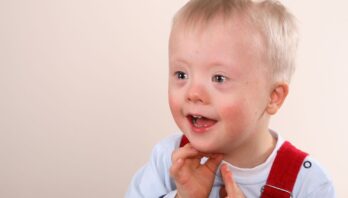Learning the History of Trauma
A trauma-informed response to children with disabilities begins with learning the child’s history of past and current abuse. Instead of trying to figure out what is “wrong” with children, we ask what happened to them and what would help them where they are, right now.
Core Values
The five core values of trauma-informed care are safety, trustworthiness, choice, collaboration, and empowerment. As you are working with children and families to support the child’s safety, seek practical ways to reflect those core values.
Families and children respond best when they know:
- They are physically and emotionally safe.
- You are trustworthy, even when the truth is difficult.
- They have choices—even during an investigation.
- You will work with them, rather than telling them what to do. You are working with them for the good of their child.
- They have some power over what happens.
(Adapted from Fallot.)
Supporting Children in Distress
Healing and recovery do occur for children and youth who survive domestic violence, sexual assault, medical trauma, bullying, and care provider abuse. First steps include addressing children’s physical needs for food, clothing, and shelter; as well as their needs for physical and emotional safety; safe connections with others; and real options for making choices and decisions.
Children who have experienced trauma are very often finely attuned to stress and anxiety within others. Our stress can increase the child’s stress, making it even more difficult to establish trust and safety. The great news is that the opposite is also true. Our calmness and ease can support the child in finding greater comfort and safety. Therefore, a key component of being a trauma-informed professional is gaining awareness of our own stress patterns and then finding effective ways to be mindful and present even when stressed. This often includes seeking support around our own needs for safety, self-care, and external validation.
Basic principles to keep in mind when supporting children in distress:
- Continually check in and assess your own level of calmness and stress.
- If you identify signs of distress within yourself, actively ground and stabilize your body and nervous system through a quick meditation or another means.
- Be mindful of your size, posture, and physical orientation to the child.
- Keep your voice calm and low, and notice how your eye contact, facial expressions, tone of voice, and gestures impact the child.
- Be attuned to the child’s needs during times of stress and transition.
(Adapted in part from Levine & Kline, 2007; and James, 1996.)
The Impacts of Trauma on Children
Traumatic events like difficult medical procedures, bullying, abuse, and neglect can seriously impact children’s physical and mental health, their sense of well-being, and how they interact with others.
When children are afraid and believe that they or someone else is in danger, they may try to physically defend against the danger by fighting back. Or, they may try to flee, or get away from the situation. Sometimes, especially when it is impossible or not safe to fight or get away, children’s response to overwhelming danger can be to physically and emotionally shut down, or freeze. This response is often the only option for infants and children, particularly children with disabilities.
When children experience overwhelming fear and danger over and over, they may begin to experience the same fight, flight, or freeze response during daily interactions with other people or when they are stressed—even long after the danger is passed. If children are not protected by others or cannot protect themselves from danger, they may begin to feel overwhelmed by emotions and fears and expect danger even when they are safe. This is particularly true if they experienced traumatic events frequently, or if the experiences were intense or lasted over long periods of time.
 In general, feeling in danger all the time can make children irritable. It can cause babies to be fussy and cry frequently, and can cause older children to act out anger. As children grow into teenagers and adults, they are at increased risk of harming themselves by abusing cigarettes, alcohol, drugs, sex, and food. They may hurt themselves and take physical risks with their bodies.
In general, feeling in danger all the time can make children irritable. It can cause babies to be fussy and cry frequently, and can cause older children to act out anger. As children grow into teenagers and adults, they are at increased risk of harming themselves by abusing cigarettes, alcohol, drugs, sex, and food. They may hurt themselves and take physical risks with their bodies.
Children with intellectual and developmental disabilities who experience traumatic events may lose some of their ability to function in day-to-day life. They may begin to have temper tantrums, cry more, destroy toys, hurt themselves, stop being able to do tasks, or withdraw.
All of these responses in children are normal reactions to the abnormal experience of being hurt, abused, or neglected. These behaviors are not character flaws, and do not mean that children are “bad” or have mental illness. Instead, these may be the only coping strategies children have developed to deal with the physical and emotional impacts of trauma, according to the Substance Abuse and Mental Health Administration.
When children are trapped in this pattern, caregivers and professionals may misunderstand or misdiagnose their behaviors, emotions, and cognitive functioning. Even if the child’s world is currently safe, the child stuck in this traumatized state may continue to experience intense terror, helplessness, hopelessness, and loss of control.
(Above section adapted in part from Levine & Kline, 2007; and James, 1996.)




